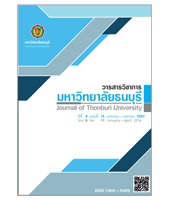การศึกษาความมั่งคั่งของการประกอบการธุรกิจแบบหนึ่งตำบลหนึ่งผลิตภัณฑ์ (OTOP)
Keywords:
หนึ่งตำบลหนึ่งผลิตภัณฑ์, กลยุทธ์น่านน้ำสีคราม, One Tambon One Product, Blue Ocean StrategyAbstract
การวิจัยครั้งนี้เป็นศึกษาความมั่งคั่งให้กับการประกอบธุรกิจแบบหนึ่งตำบลหนึ่งผลิตภัณฑ์ ที่กรมพัฒนาชุมชน กระทรวงมหาดไทย ดูแลรับผิดชอบโดยมีวัตถุประสงค์เพื่อศึกษาวิธีการสร้างความมั่งคั่งโดยดูความสัมพันธ์ระหว่างประสบการณ์เจ้าของธุรกิจแบบหนึ่งตำบลหนึ่งผลิตภัณฑ์ (OTOP) กับระดับการบูรณาการกลยุทธ์น่านน้ำ สีคราม (Blue Ocean Strategy) ที่กรมพัฒนาชุมชน กระทรวงมหาดไทยดูแลรับผิดชอบ
จากการศึกษาสภาพแวดล้อมทางธุรกิจและเพื่อเปรียบเทียบความแตกต่างของการบูรณาการกลยุทธ์น่านน้ำสีคราม (Blue Ocean Strategy) เพื่อสร้างความมั่งคั่งให้กับองค์กร โดยการประเมินจากกลุ่ม โครงการเครือข่ายองค์ความรู้ Knowledge Based OTOP (KBO) ซึ่งเป็นกลุ่มผู้ประกอบการโอทอป (OTOP) ที่ทางรัฐบาลได้คัดเลือกมาแล้วว่าเป็นกลุ่มที่ประสบความสำเร็จในทุกๆ ด้าน ทั้งด้านการพัฒนาผลิตภัณฑ์ การบรรจุภัณฑ์ ด้านการผลิตและการหาช่องทางการตลาด โดยที่ผลิตภัณฑ์เหล่านั้นเป็นผลิตภัณฑ์ที่มีมาตรฐาน สามารถขายได้ดีและเป็นที่นิยมในท้องตลาด ผู้ประกอบการที่ถูกคัดเลือกให้อยู่ในกลุ่ม โครงการเครือข่ายองค์ความรู้ Knowledge Based OTOP (KBO) นี้คือผู้ที่ได้เป็นแชมป์ประจำจังหวัดซึ่งได้จากการคัดเลือกในงาน OTOP KBO Contest ประจำปี 2553 ที่จัดขึ้นระหว่าง 21-29 สิงหาคม 2553 และกลุ่มตัวอย่างที่ทำการศึกษาเหล่านี้ได้รับการคัดเลือกให้มาออกงานโอทอปซิตี้ (OTOP CITY 2010) ระหว่างวันที่ 18 - 26 ธันวาคม 2553 ณ เมืองทองธานี ซึ่งทำให้กลุ่มผู้วิจัยสนใจผู้ประกอบการเหล่านี้เพื่อศึกษาว่าจะสามารถพัฒนาผลิตภัณฑ์ OTOP ให้เกิดความมั่งคั่งได้อย่างไร
จากการประเมินกลุ่ม KBO จำนวน 39 ราย จากทั้งหมด 40 ราย ซึ่งกลุ่มตัวอย่างนี้ได้จากกลุ่มผู้ประกอบการที่มาออกงานทั้งหมด เครื่องมือที่ใช้ในการวิจัยเป็นแบบประเมินที่มีลักษณะเป็นมาตราส่วนประเมินค่า 5 ระดับมีค่าความเชื่อมั่นเท่ากับ 0.95 สถิติที่ใช้ในการวิเคราะห์ข้อมูลคือ ค่าร้อยละ ค่าเฉลี่ย ค่าส่วนเบี่ยงเบนมาตรฐาน และการทดสอบค่าที (t-test)
ผลการวิจัยสรุปได้ดังนี้
1. ผู้ประกอบธุรกิจแบบหนึ่งตำบลหนึ่งผลิตภัณฑ์ พบว่าผู้ประกอบการกลุ่มตัวอย่างส่วนใหญ่ คาดว่ามียอดขายเฉลี่ยต่อเดือนประมาณ 100,000 - 199,999 บาท ร้อยละ 33.30 น้อยกว่า 100,000 บาท คิดเป็นร้อยละ 28.20 มากกว่า 300,000 บาท ร้อยละ 25.60 และอยู่ระหว่าง 200,000 - 299,999 บาท ร้อยละ 12.90
ผู้ประกอบธุรกิจแบบหนึ่งตำบลหนึ่งผลิตภัณฑ์ พบว่าผู้ประกอบการกลุ่มตัวอย่างส่วนใหญ่จะได้กำไรสุทธิ ต่อปีประมาณ 21 - 40 เปอร์เซ็นต์ของยอดขาย ร้อยละ 46.20 มีกำไรประมาณ 41 - 60 เปอร์เซ็นต์ของยอดขาย ร้อยละ 28.20 น้อยกว่า 20 เปอร์เซ็นต์ของยอดขาย ร้อยละ 15.40 และมีกำไร 61 - 100 เปอร์เซ็นต์ของยอดขาย ร้อยละ 10.20 ผู้ประกอบธุรกิจแบบหนึ่งตำบลหนึ่งผลิตภัณฑ์ พบว่าผู้ประกอบการกลุ่มตัวอย่างส่วนใหญ่จะมีลูกค้ารายใหญ่กลับมาซื้อซ้ำเป็นประจำทุกๆ เดือน คิดเป็นร้อยละ 51.30
2. ความสัมพันธ์ระหว่างความคิดเห็นของผู้ประกอบธุรกิจแบบหนึ่งตำบลหนึ่งผลิตภัณฑ์ในด้านการวิเคราะห์สภาพแวดล้อมภายนอกระดับมหภาค พบว่าผู้ประกอบการโดยรวมมีความเห็นในการวิเคราะห์สภาพแวดล้อมอยู่ในระดับมาก อันดับ 1 ในเรื่องการพัฒนาผลิตภัณฑ์ใหม่ออกสู่ตลาดเพื่อสร้างความได้เปรียบทางการแข่งขันในอุตสาหกรรม อันดับที่ 2 ผลิตภัณฑ์ยังเป็นที่ดึงดูดใจของลูกค้าเมื่อเทียบกับสินค้าใกล้เคียงกับลูกค้าตอบสนองต่อการปรับเปลี่ยนผลิตภัณฑ์ อันดับที่ 3 การออกแบบผลิตภัณฑ์โดยเพิ่มเอกลักษณ์พิเศษ เช่น วัฒนธรรมของแหล่งผลิต มีผลต่อการตัดสินใจซื้อของลูกค้ากับการเพิ่มความหลากหลายของผลิตภัณฑ์มีผลมาจากความต้องการกำไรที่เพิ่มขึ้น อันดับที่ 4 ลูกค้าให้ความสนใจต่อผลิตภัณฑ์ อันดับที่ 5 ผลิตภัณฑ์ของท่านเป็นที่ต้องการของตลาด และอันดับท้ายสุดคือการแทรกแซงนโยบายของรัฐบาลมีผลทำให้ท่านต้องปรับปรุงผลิตภัณฑ์
3. ความสัมพันธ์ระหว่างความคิดเห็นของผู้ประกอบธุรกิจแบบหนึ่งตำบลหนึ่งผลิตภัณฑ์ พบว่า ผู้ประกอบการมีความคิดเห็นเกี่ยวกับกลยุทธ์น่านน้ำสีคราม (Blue Ocean Strategy) โดยรวมอยู่ในระดับมาก เมื่อผลการวิเคราะห์ในรายละเอียดจะเห็นว่าผู้ประกอบธุรกิจแบบหนึ่งตำบลหนึ่งผลิตภัณฑ์ให้ความเห็นในอันดับที่ 1 คือเรื่องของการที่ผลิตภัณฑ์มีความแปลกใหม่และแตกต่างจากคู่แข่ง ช่วยสร้างความพึงพอใจต่อลูกค้า กับการที่ผลิตภัณฑ์มีคุณค่าเพิ่มขึ้นส่งผลให้ลูกค้าตัดสินใจซื้อ อันดับที่ 2 คือเรื่องผลิตภัณฑ์มีคุณสมบัติใหม่ที่เหนือกว่าคู่แข่งขันในท้องตลาด อันดับที่ 3 คือเรื่องผลิตภัณฑ์มีคุณค่าเพิ่มขึ้นกว่าผลิตภัณฑ์ในท้องตลาด อันดับที่ 4 ผลิตภัณฑ์มีเฉพาะคุณสมบัติที่จำเป็นตามที่ลูกค้าต้องการ อันดับที่ 5 ผลิตภัณฑ์เกิดจากแรงบันดาลใจส่วนบุคคลและความเป็นไปได้ทางการตลาดในผลิตภัณฑ์ก่อนการพัฒนาผลิตภัณฑ์ และอันดับสุดท้าย คือเรื่อง ผลิตภัณฑ์ มีคุณสมบัติที่จำเป็นขั้นพื้นฐานในขณะที่สามารถขายได้ในราคาต่ำกว่าคู่แข่งขัน
A Study of Wealth Creation by the Blue Ocean Strategy: The Case Study of OTOP Entrepreneurs in Thailand
The research aims to study the wealth of the OTOP entrepreneurs, who operate their business under the supervision of the Community Development Department, Ministry of Interior. The objectives of the research include: Firstly, it is to investigate the methods of wealth enhancement related to the experiences of OTOP operators in association with the integrated approach of the Blue Ocean Strategy under the Community Development Department’s strategic framework. Secondly, it is to compare business environments and different ways of integrating the Blue Ocean Strategy in their OTOP assessed from the knowledge-based OTOP (KOB) groups which were selected by the government from provincial champions of the ‘OTOP KOB Contest 2010 Fair held from 21-29 August 2010 and later participated in the OTOP CITY 2010 Fair from 18-26 December 2010 held at Muangthong Thani Center. The KBO group involves those entrepreneurs, which are successful in all types of the business operations including products and packaging development, production, and marketing channels. Therefore, the researchers study how these OTOP entrepreneurs develop the wealth of their OTOP products.
From the assessment of the KBO groups of 39 out of entrepreneurs, a research tool employed a Likert-scale of a questionnaire designed to collect data and achieved a reliability of 0.95 , while statistic analyses of percentage included mean, standard deviation and t-test.
The research found the following remarks:
1. Regarding to the Monthly Sale amount, the majority of the number of OTOP entrepreneurs or 33.30% of them made a monthly sale of 100,000 to 199,999 baht; 28.20% made less than 100,000 baht; 25.60% made more than 300,000 baht per month; and, 12.90% made between 200,000 to 299,999 baht. In terms of Yearly Net Profit, the majority of the number of OTOP entrepreneurs earned a yearly net profit of 21-40% from the total yearly sales amount of 46.20%. With a yearly net profit of 41-60%, the total sales amount was 28.20%; with a yearly net profit of less than 20%, the total sales amount was about 15.40%; and, with a yearly net profit of 61-100%, the total sales amount was 10.20%. It was also found out that their major customers returned to buy the OTOP products on a monthly basis accounted for 51.30%.
2. Referring to the Business Environment Influences on a macro basis, it was found that the highest level of influential factor was to create a new product to gain a competitive advantage within the industry, the second factor was the attractiveness of products in comparison to those of competitors, the third factor was the design of product with a uniqueness (culture of products) influencing a customer’s decision and increasing variety of product because of increasing profit needs. The forth factor was the customers’ interests, and the fifth factor was the product needed in a market. The last factor was the government intervention affects the changes of a company’s product. Pertaining to the Blue Ocean Strategy integration, the overall view found the high level of the strategy application. In each view, the highest percentage result found that if a company’s product was uniquely new and different from a competitor, it would satisfy customers and if a product was value added, it would make customers decide to buy the products.The second was the better attribute of a company’s products in comparison to competitors, while the third factor was the product that was value added in comparison to the existing ones. The forth factor was the available product’s attributes when needed. The fifth factor was that the product served an individual customer’s inspiration and individual’s market feasibility before R&D. The final factor posed the product’s fundamental attributes with a cheaper price over a competitor.







